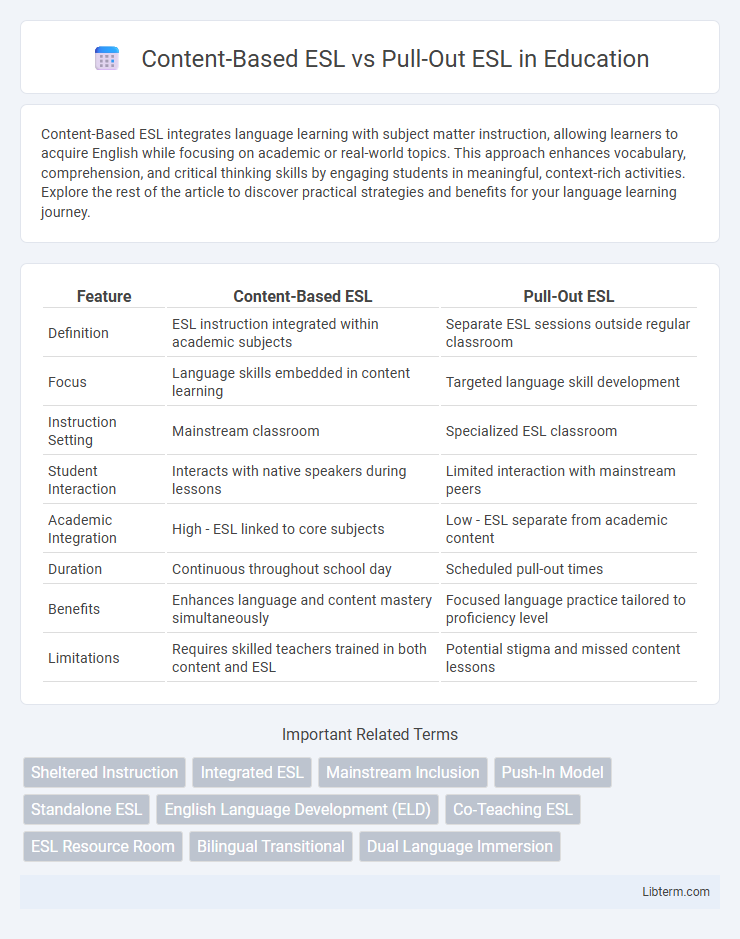Content-Based ESL integrates language learning with subject matter instruction, allowing learners to acquire English while focusing on academic or real-world topics. This approach enhances vocabulary, comprehension, and critical thinking skills by engaging students in meaningful, context-rich activities. Explore the rest of the article to discover practical strategies and benefits for your language learning journey.
Table of Comparison
| Feature | Content-Based ESL | Pull-Out ESL |
|---|---|---|
| Definition | ESL instruction integrated within academic subjects | Separate ESL sessions outside regular classroom |
| Focus | Language skills embedded in content learning | Targeted language skill development |
| Instruction Setting | Mainstream classroom | Specialized ESL classroom |
| Student Interaction | Interacts with native speakers during lessons | Limited interaction with mainstream peers |
| Academic Integration | High - ESL linked to core subjects | Low - ESL separate from academic content |
| Duration | Continuous throughout school day | Scheduled pull-out times |
| Benefits | Enhances language and content mastery simultaneously | Focused language practice tailored to proficiency level |
| Limitations | Requires skilled teachers trained in both content and ESL | Potential stigma and missed content lessons |
Understanding Content-Based ESL
Content-Based ESL integrates English language instruction with subject matter teaching, enabling students to learn academic content while developing language skills in context. This approach contrasts with Pull-Out ESL, where students are removed from mainstream classes for separate language instruction, potentially limiting their exposure to grade-level content. By embedding language learning within content areas such as science or social studies, Content-Based ESL promotes deeper comprehension and practical language use.
What Is Pull-Out ESL?
Pull-Out ESL is a specialized instructional approach where English Language Learners (ELLs) are temporarily removed from mainstream classrooms to receive targeted language support in a separate setting. This method emphasizes individualized or small group lessons to improve specific English skills such as speaking, listening, reading, and writing. It contrasts with Content-Based ESL, which integrates language learning within subject matter instruction, focusing on simultaneous content comprehension and language development.
Key Differences Between Content-Based and Pull-Out ESL
Content-Based ESL integrates language instruction with academic subjects, enabling students to develop English proficiency while learning core curriculum topics. Pull-Out ESL involves removing students from mainstream classrooms for specialized language support, focusing solely on language acquisition without simultaneous subject content learning. Key differences lie in instructional context, with Content-Based ESL promoting simultaneous content and language development, whereas Pull-Out ESL emphasizes isolated language skill improvement outside academic content.
Advantages of Content-Based ESL Instruction
Content-Based ESL instruction enhances language acquisition by integrating English learning with academic subjects, promoting deeper comprehension and practical application of language skills. This approach supports cognitive development and contextual learning, enabling students to simultaneously master content knowledge and language proficiency. It fosters greater student engagement and motivation by connecting language learning to real-world topics and academic goals.
Benefits of Pull-Out ESL Programs
Pull-Out ESL programs offer targeted language instruction tailored to individual student needs, promoting accelerated English proficiency development. These programs facilitate focused support in smaller groups, enhancing students' ability to grasp academic vocabulary and grammar essential for mainstream classroom success. Pull-Out ESL also provides opportunities for regular progress monitoring and personalized feedback, ensuring more effective language acquisition outcomes.
Challenges Faced in Content-Based ESL
Content-Based ESL programs often face challenges such as language barriers that hinder students' comprehension of subject-specific vocabulary and concepts, leading to slower academic progress. Teachers may struggle with balancing language instruction and content delivery, requiring specialized training to effectively integrate ESL support into mainstream curricula. Limited resources and insufficient collaboration between ESL and content teachers further complicate addressing diverse student needs in Content-Based ESL settings.
Limitations of Pull-Out ESL Approach
Pull-out ESL programs often isolate English learners from mainstream classrooms, limiting their exposure to grade-level content and social interaction with native speakers. This separation can cause students to miss critical content instruction, resulting in slower academic progress and language development. The approach may also lead to stigmatization and decreased motivation among ESL students due to reduced integration with peers.
Student Outcomes: Comparing Both Models
Content-Based ESL programs integrate language instruction with academic content, leading to improved comprehension and higher engagement in subject matter for ESL students. Pull-Out ESL models provide focused language development in separate sessions, which can enhance specific linguistic skills but may limit exposure to grade-level content. Research indicates Content-Based ESL often results in better academic achievement and long-term language proficiency compared to Pull-Out ESL approaches.
Choosing the Right ESL Model for Your School
Content-Based ESL integrates language instruction with subject matter teaching, enhancing comprehension and academic achievement for English learners by immersing them in curriculum-relevant vocabulary and concepts. Pull-Out ESL separates students from mainstream classrooms, providing targeted language support that can improve foundational skills but may limit exposure to grade-level content. Selecting the right ESL model requires evaluating your school's resources, student population needs, and academic goals to balance language development with content mastery effectively.
Future Trends in ESL Program Delivery
Content-Based ESL programs integrate language instruction with academic subjects, promoting deeper learning and cognitive development, while Pull-Out ESL offers targeted language support in separate sessions. Future trends suggest a shift toward hybrid models leveraging technology to personalize learning and facilitate seamless integration of language skills across curricula. Emerging AI tools and data analytics will enhance adaptive instruction, improving outcomes and engagement for diverse ESL learners.
Content-Based ESL Infographic

 libterm.com
libterm.com